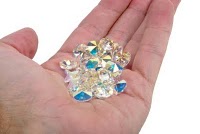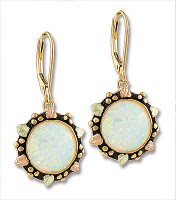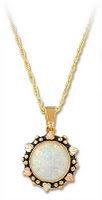APPEARANCE OF THE OPAL
The Opal has no crystalline structure, as do most gemstones, but instead is comprised of varying sizes of minute, spherically grouped chains of silicon and oxygen. The more precious the Opal, the more organized the groups of spheres and the more consistent their sizes. This resulting structure creates a changing play of colors as light is dissected and diffracted through the spheres at different wavelengths creating all the colors of the rainbow. It is this colorful, translucent appearance that gives us the term “opalescence”.
HISTORY OF THE OPAL
Almost 95% of all Opals come from Australia, where billions of years ago a vast sea which covered parts of Australia created just the right mineral deposits for their creation. The remaining percentage comes from Mexico, northern Brazil, the northwestern US, Canada and Africa. Until as late as the mid-19th century, however, Opals were fairly rare. An accidental discovery in Australia at that time changed the fate of the Opal forever. Now one of the most charismatic of gemstones, the Opal is believed to have healing powers which are more exemplified in people born under the sign of Cancer.
 The Greeks believed that the Opal was formed from tears of joy as Zeus wept after defeating the Titans. The Romans considered Opals symbolic of purity and believed them to prevent eye disease. And the Opal is of significant spiritual value in Aboriginal mythology as well.
The Greeks believed that the Opal was formed from tears of joy as Zeus wept after defeating the Titans. The Romans considered Opals symbolic of purity and believed them to prevent eye disease. And the Opal is of significant spiritual value in Aboriginal mythology as well.
There are several origins for the name Opal. One is that it is derived from Sanskrit “upala”, meaning “precious stone”. The Greeks knew it by “opallios”, meaning “color change”, while the Romans referred to it as “opalus”, which translates to “stone from many elements”.
MODERN USES OF THE OPAL
Several types of Opal are particularly popular: Black Opals have a dark base which shows a more brilliant play of colors; Boulder Opal, which is a thick layer of Opal fused to brown host rock; and White Opals, the least expensive Opals, show a more diffused spectrum of colors.
Bearing a Mohs’ Hardness rating of 5.5-6, Opals are not very hard. They also contain a considerable amount of water, which generally varies between 2 and 6%, but can be more. This varying percentage of water can make Opals brittle. For these reasons, care should be taken when cleaning them.
The Opal is also the birthstone for the month of October. It is also used to celebrate the fourteenth wedding anniversary, and as an alternate for the twelfth wedding anniversary. If your birthday is in the month of October, consider a pair of Opal earrings and perhaps a matching Opal pendant made from Black Hills Gold. Landstroms is the original manufacturer of Black Hills Gold jewelry and every piece in their line is painstakingly made by hand in their South Dakota factory.
***If you’ve enjoyed this article, please link back to us at:
https://blackhillsgoldblog.com/?p=939
Read the original article here: Opal – October’s Birthstone

